Table of Contents
Do you want to work on your abs, but only know the classic sit-ups or planks? In that case, this article will open up a whole new world for you, where it’s definitely not necessary to do hundreds of repetitions of one exercise. You will find effective exercises for the straight, oblique, and lower abs for both beginners and advanced individuals. These exercises will not only give you a stronger core, which is crucial for proper body posture and functional strength, but also help you achieve a noticeably firmer and more toned abdomen. It will not only look great, but also contribute to improved athletic performance.
How to go about training your abs?
The abdominal muscles are not just about the six-pack. They consist of the rectus abdominis, transversus abdominis, external obliques, and internal obliques. To comprehensively strengthen the entire abdominal region, it’s important to include exercises in your training routine that engage all these muscle groups. [1]
The same rules apply to training the abdominal muscles as with all other muscle groups. Before you begin, don’t forget to warm up adequately, such as by taking a brisk walk on the treadmill or using a skipping rope. Then, move on to the main part of the workout and focus on familiarizing yourself with the proper technique for each exercise. Only after that should you add weights or try more challenging variations.
From the introduced exercises, you can easily put together a gym training plan for your abs. To start off, choose 3–5 exercises and perform them in 3 working sets with a range of 10–20 reps per set. If you’re focusing on endurance, such as with the plank exercise, aim to hold the position for 10–60 seconds, depending on your level of fitness. You can add the ab exercises to your shoulder, arm, or other muscle group workouts, or perform them as a standalone session. Additionally, you can create a circuit training or high-intensity interval training (HIIT) using these exercises.
To achieve results, it’s important to maintain consistency when training your abs. However, it’s not advisable to overload this muscle group and work it every day, as it wouldn’t allow for proper muscle recovery. Beginners are recommended to perform a comprehensive ab workout 2–3 times a week, while advanced individuals can increase it to 4 times a week. Keep in mind that complete muscle recovery after strength training typically takes an average of 24–72 hours. Therefore, when planning your training routine and the number of sessions per week for a specific muscle group, consider the time needed for muscle recovery. [2–4]
If you want to both slim down and tone your abs, you’ll need a more comprehensive approach. The following article can help you in achieving a slim and toned abdomen: Lose Belly Fat and Get Into Shape With Our Simple Guide.

13 most effective ab exercises
By incorporating these exercises, you can comprehensively train both the superficial and deep abdominal muscles, which make up the core. These exercises are ideal for the gym, but most of them can also be performed at home with just an exercise mat and your body weight. For some exercises, you can utilize equipment such as dumbbells, kettlebells, weight plates, a weight bench, a pull-up bar, or parallel bars with back support.
1. Sit-Ups
- Starting position: Lie on your back with your knees bent and heels or the entire feet resting on the ground. Lightly touch your fingertips to the sides of your head and keep your elbows open. If you find yourself wanting to pull your elbows together, cross your hands over your chest. You can also place a folded towel or an ABmat under the lower back to effectively engage the abdominal muscles.
- Execution: Exhale and activate your abdominal muscles as you gradually lift your head, upper back, and lower back off the mat, straightening your entire torso. Keep facing forward and avoid any excessive tilting of the head. Then, inhale and return to the starting position in a controlled manner. Repeat the exercise.
- Common mistakes: Pressing hands against the head too much, limited range of motion, insufficient activation of the abdominal muscles.
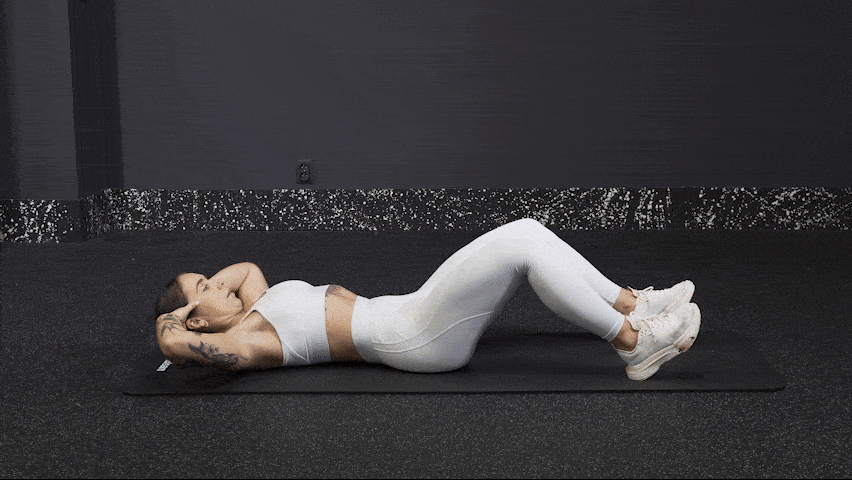
Other variations of the exercise:
1. Weighted Sit-Ups
The starting position remains the same, with the difference that you hold a weight plate, dumbbell, or kettlebell with both hands in front of your chest. As you move upwards, gradually straighten your arms until they are fully extended overhead. Then, return to the starting position in a controlled manner and continue with additional repetitions.
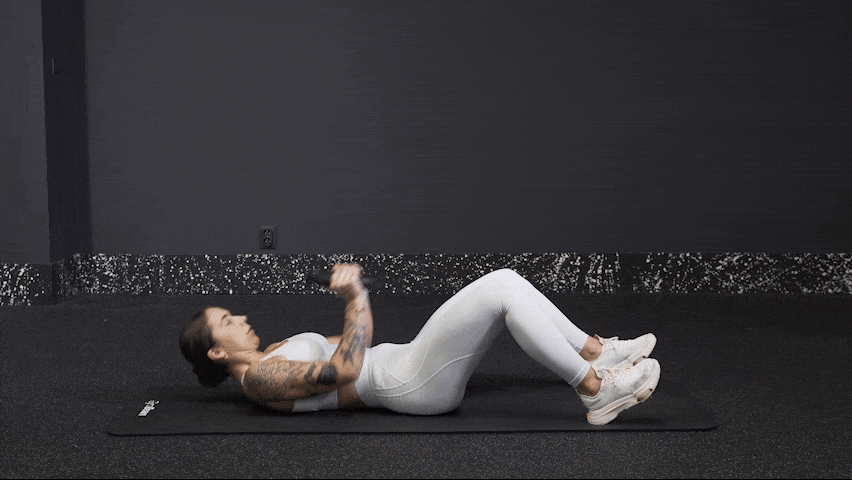
2. Medicinbal Sit-Ups
This exercise is a common part of CrossFit workouts. It differs from the basic variation in that you bend your knees, bring your feet together, and point your knees outward. While lying down, extend your arms and hold a medicine ball with both hands. Afterwards, activate your abdominal muscles and lift yourself off the ground along with the medicine ball, touch the ground in front of your feet with the ball, and then return to the starting position. This variation is slightly more challenging and is suitable for more advanced individuals.
You might be interested in these products:
2. V-Ups
- Starting position: Lie on your back and extend your arms overhead. Keep your legs straight and lift them a few centimetres off the ground.
- Execution: Exhale and activate your abdominal muscles as you lift your head and entire torso off the mat. At the same time, pull your slightly bent knees towards your chest and try to touch your feet with your hands. Then, inhale and return to the starting position. Repeat the exercise.
- Common mistakes: Limited range of motion, uncontrolled movement, arching the back.
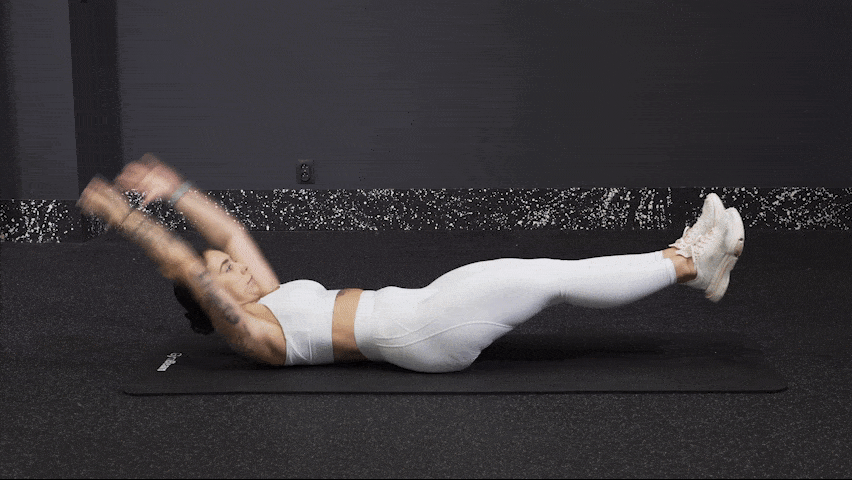
Other variations of the exercise:
1. Weighted V-Ups
You can also make this exercise more challenging by using a dumbbell, weight plate, or a lighter medicine ball held with both hands. Additionally, you can add wrist or ankle weights to increase the intensity of the exercise.
3. Hollow Hold
- Starting position: Lie on your back with your arms extended overhead. Keep your legs straight and lift them approximately 20–30 centimetres off the ground.
- Execution: Inhale and exhale freely, and try to hold this position for at least 10 seconds. You can make the exercise easier if you bend your legs more and lift them higher. On the other hand, you can make it more challenging if you straighten your legs and lower them. After the hold, lower your legs, take a brief rest, and proceed with the next repetition.
- Common mistakes: Insufficient duration of the hold, lifting the lower back off the ground.
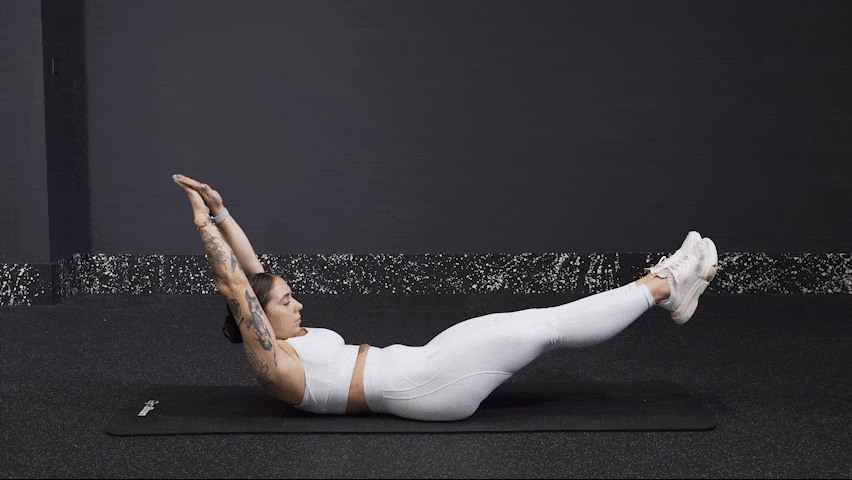
Other variations of the exercise:
1. Weighted Hollow Hold
You can also make this exercise more challenging by using a lighter dumbbell or weight plate held with both hands. Similarly, adding wrist or ankle weights can also be effective.
2. Hollow Rock
Instead of holding the static position, you can gently rock back and forth while doing this exercise. The goal is to maintain a stable position, especially in the core, while allowing your body to sway. Simply move your upper and lower limbs up and down by a few centimetres.
4. Sprinter Crunch
- Starting position: Lie on your back with your legs extended. Lift your head and feet a few centimetres off the mat, while keeping your arms relaxed by your sides.
- Execution: Exhale and activate your abdominal muscles as you lift and bend your left leg. Simultaneously, lift your right arm and bring your palm closer to your left foot. Then, inhale and return to the starting position, and repeat the same movement on the other side.
- Common mistakes: Limited range of motion, uncontrolled movement.
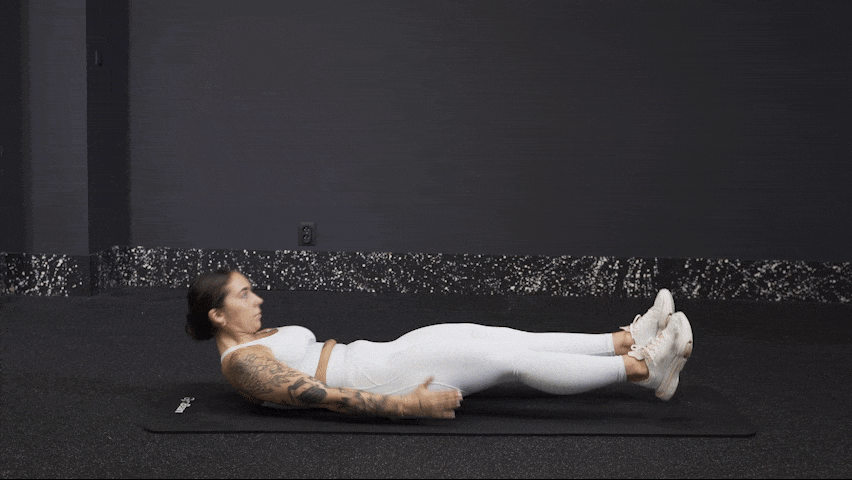
Other variations of the exercise:
1. Weighted Sprinter Crunch
You can also make this exercise more challenging by attaching ankle weights.
5. Reverse Crunch
- Starting position: Lie on your back with your arms resting comfortably by your sides. Bend your knees slightly and lift your legs off the ground.
- Execution: Exhale and activate your abdominal muscles as you lift your pelvis and lower back a few centimetres off the ground. Inhale as you return to the starting position, and repeat the exercise. Focus on initiating the movement with your abdominal muscles.
- Common mistakes: Limited range of motion, insufficient activation of the abdominal muscles, uncontrolled movement.
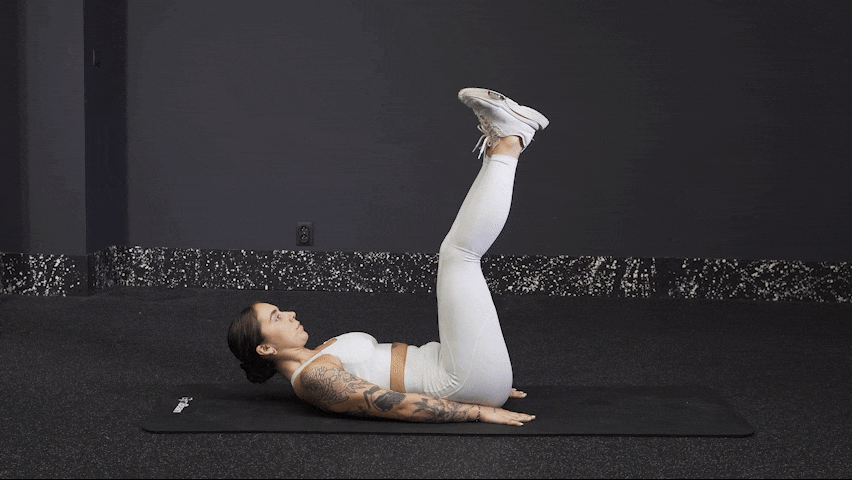
Other variations of the exercise:
1. Fit Ball Reverse Crunches
You can also use a fitness ball for this exercise. Place the ball between your ankles and squeeze it firmly. Then, perform the same movement as in the basic variation by lifting your pelvis and legs upwards.
6. Mountain Climber
- Starting position: Kneel on the ground and transition into a straight plank position. Place your palms on the floor, slightly wider than shoulder-width apart, with fingers spread open. Position your shoulders away from your ears and squeeze your shoulder blades together. Engage your core and strive to maintain a straight alignment of your body. Avoid arching your back, especially in the lumbar region.
- Execution: Exhale and bend one leg, bringing it towards the extended arm’s elbow. Then, return it to the starting position and immediately repeat the same movement on the other side.
- Common mistakes: Arching the back, allowing the hips to sag towards the ground, lifting the pelvis upward too much, insufficient range of motion.

Other variations of the exercise:
1. Stability Ball Mountain Climber
You can test your stability during this exercise by using a fitness ball or a balance pad. Lean on it with your hands and then perform the exercise in the same way as in the basic variation.
7. Dumbbell Russian Twist
- Starting position: Sit on the mat with an upright posture with your back gently tilted backward. Keep your head aligned with your spine. Bend your knees at a 90-degree angle and lift them off the ground until your shins are parallel to the floor. Beginners can lift their legs just a few centimetres off the mat or keep them on the ground. Firmly grasp a dumbbell with both hands at both ends.
- Execution: Exhale and perform an upper body and arm rotation with the dumbbell to one side. Focus on engaging your abdominal muscles and maintaining a straight back throughout the movement. Then smoothly rotate to the other side.
- Common mistakes: Limited range of motion, arching the back.
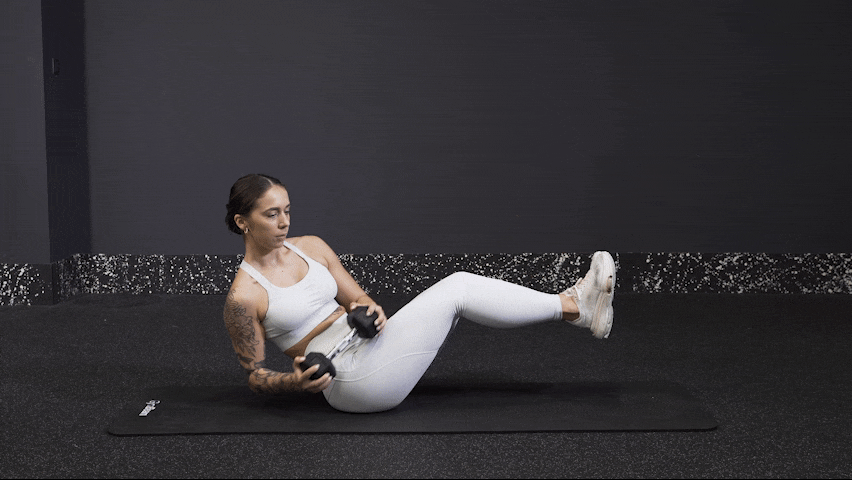
Other variations of the exercise:
1. Kettlebell Russian Twist
Instead of a dumbbell, you can use a kettlebell, medicine ball, or slam ball for this exercise. Perform it in the same way as the basic variation.
8. Weighted Plank
- Starting position: Kneel on the ground and transition into a forearm plank position. Place a weight plate on your lower back. If you need assistance, ask a gym buddy for help. Your shoulders should be down, away from your ears, and your shoulder blades pulled toward each other. Your elbows should be at approximately a 90-degree angle with your body. Activate your core and aim to maintain a straight and aligned posture. Avoid arching your back, especially in the lumbar region.
- Execution: Inhale and exhale freely, engage your core, and try to hold this position for a few seconds (time yourself using a sports watch or your phone). Then, remove the weight plate from your back, kneel down, take a moment to rest, and you can proceed with another round of the plank hold.
- Common mistakes: Arching the back, allowing the hips to sag towards the ground, lifting the pelvis upward too much.
If you are interested in how regular planking can affect your body, be sure to check out our article: How Can the Plank Exercise Change Your Body? Six-Pack, Stronger Core and Better Athletic Performance.
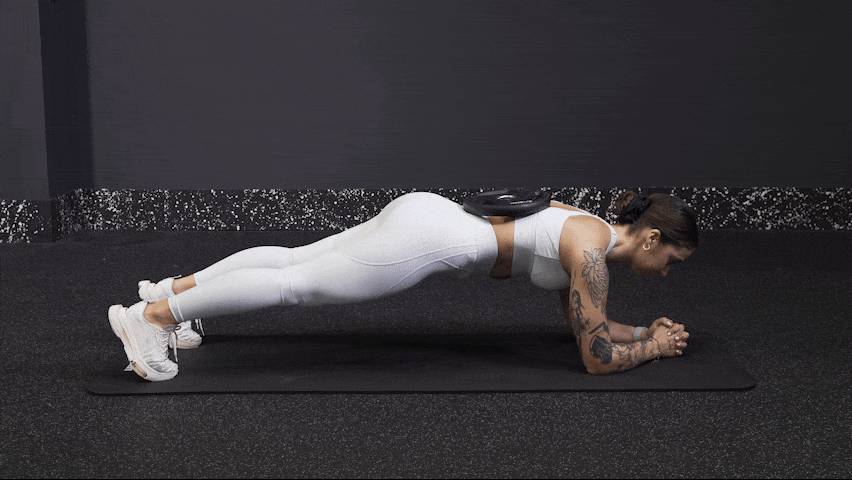
Other variations of the exercise:
1. Plank
Beginners should opt for the standard plank without additional weight. You can perform it either on your forearms or with your arms straight.
2. Stability Ball Plank
A more challenging variation is performing the plank on a fitness ball or other balance device. Lean on it with your upper or lower limbs and try to maintain a stable position, just like you would do with a standard plank.
3. Suspended Plank
You can also spice up your abdominal workout with a suspended plank on a suspension training set. Place your feet in the loops, lift yourself until your arms are straight, and then once again maintain a stable body position.
9. Side Plank
- Starting position: Lie on your side with your legs extended. Keep your feet stacked on top of each other or behind each other. Lift yourself on your forearm and activate your core while lifting your other arm towards the ceiling.
- Execution: Inhale and exhale freely, hold and try to maintain this position for a few seconds. Then take a brief rest, switch sides and repeat.
- Common mistakes: Arching the back, allowing the hips to sag towards the ground.
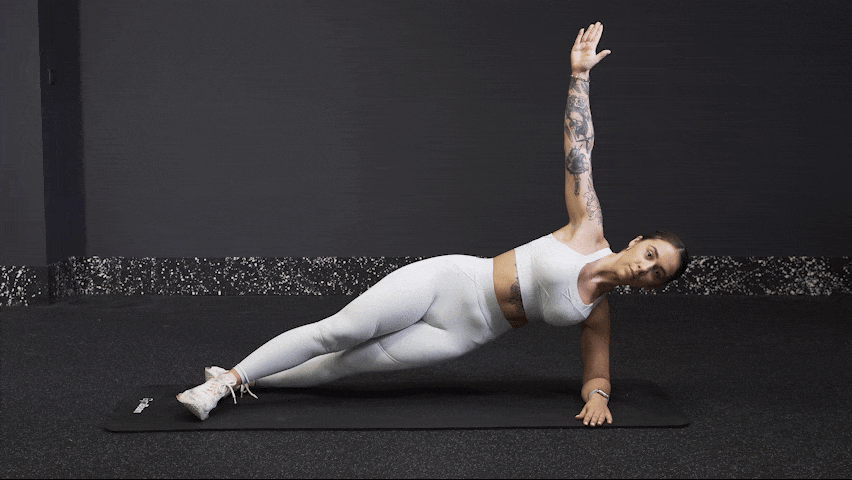
Other variations of the exercise:
1. Side Plank Hip Dips
The starting position remains the same, just place your upper arm by your side. Then, lower your hips a few centimetres closer to the ground and bring them back to the starting position. Perform 6–12 repetitions and then switch sides.
2. Side Plank Leg Raise Hold
In this plank variation, you’ll be literally a star. In the starting position, lift your upper arm and leg upwards, resembling a star shape. Try to hold this position for a few seconds, then take a short break before switching sides.
10. Bench Crunches
- Starting position: Sit on a flat bench or box. Keep your back upright and slightly tilt back. Grab the edges with your hands, lift your legs to the height of the bench, and keep your knees slightly bent.
- Execution: Exhale and activate your abdominal muscles as you bend your knees and bring them toward your chest. At the same time, flex your torso forward to meet your knees. Then, inhale and return to the starting position, and repeat the exercise.
- Common mistakes: Limited range of motion, arching the back.

Other variations of the exercise:
1. Side Bench Crunches
If you want to target the oblique abdominal muscles more, try pulling your knees towards the respective shoulder. Alternate between pulling towards the right and left shoulder.
2. Weighted Bench Crunches
You can make the exercise more challenging by adding weight in the form of ankle weights or by holding a small dumbbell firmly between your feet.
11. Parallel Bar Knee Raises
- Starting position: Hang from the parallel bars with your elbows resting on the bars and your back supported. Let your legs hang straight down.
- Execution: Exhale and simultaneously activate your abdominal muscles as you pull your knees towards your chest. Then, lower them down in a controlled manner and continue with the next repetition.
- Common mistakes: Uncontrolled movement, using leg swing momentum, limited range of motion.
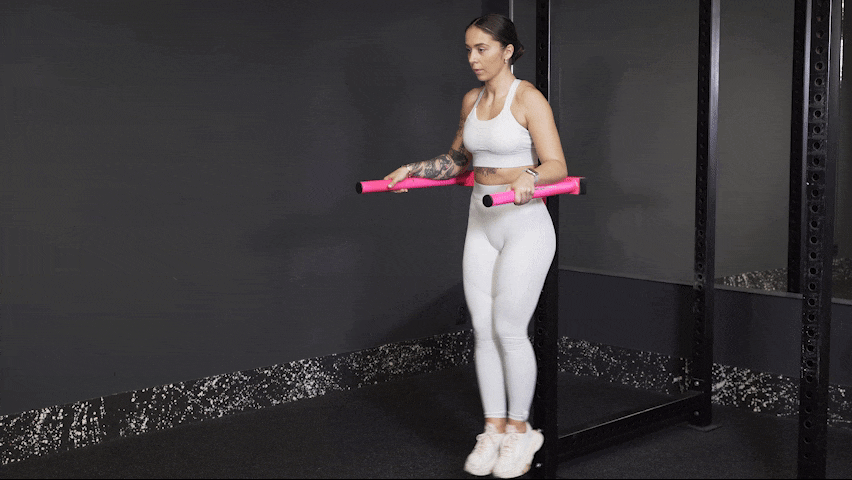
Other variations of the exercise:
1. Parallel Bar Side Knee Raises
If you bring your knees towards the sides (towards your shoulders), you will also engage the oblique abdominal muscles.

12. Parallel Bar L-Sit
- Starting position: Hang from the parallel bars with your elbows resting on the bars and your back supported. Let your legs hang straight down.
- Execution: Exhale and activate your abdominal muscles as you lift your slightly bent legs up towards the height of the parallel bars. Then lower them down in a controlled manner and continue with another repetition.
- Common mistakes: Uncontrolled movement, using leg swing momentum, limited range of motion.

13. Hanging Knee Raises
- Starting position: Hang from a pull-up bar, retract your shoulder blades, and keep your legs extended.
- Execution: Exhale and activate your abdominal muscles as you bring your knees towards your torso. Keep your shoulder blades pulled down throughout the movement. Inhale as you return to the starting position and repeat the exercise. If you start swinging while hanging, briefly hang still, tighten your core, and regain control of the movement.
- Common mistakes: Swinging, uncontrolled movement, lifting the shoulder blades, using leg swing momentum.

Other variations of the exercise:
1. Rings Hanging Knee Raises
If you have gymnastic rings at hand, you can hang from them and perform the same exercise. However, keep in mind that you may experience more swinging, which requires greater control of movement and engagement of your core muscles.
2. Toes To Bar
A more challenging variation is to bring your extended legs up towards the bar. While hanging, lift your legs until your toes touch the bar. You don’t have to reach your maximum height with the first repetition. You can start with your legs at hip height and gradually increase the range of motion with each repetition.
A pull-up bar can be used to perform exercises targeting the entire upper body. You can find the most effective ones in our article: Learn How to Exercise on a Pull-up Bar With These 10 Exercises for Beginners and Advanced Athletes
What’s next?
- If you are looking for other bodyweight exercises that would target the hips, oblique abdominal muscles or the core, be sure to check out our article: 21 Best Bodyweight Ab Exercises
- You can also try abdominal exercises using a fit ball with the help of the following article: 10 Effective Core & Booty Exercises With Fit Ball
- In case you don’t have much time to spare, try our Effective 6-Minute Abs Workout at Home.
- If your dream is to have visible six-pack abs, and you’re interested in how to get them, check out the following articles for helpful tips: A Proven Guide to a Six-Pack: Diet and Training Routine for Sculpted Abs + 9 Tips for a Toned Six-Pack
- Are you interested in learning how to properly structure a complete training plan? You can find detailed information on this topic in our article: How to Create a Quality Gym Training Plan?
What are the main takeaways?
The aforementioned exercises will help you on your journey towards strong and toned abs. You can choose bodyweight exercises, incorporate weights, or reach out for a pull-up bar. If you’re just starting out with ab training, you should opt for the basic variations of the exercises and gradually increase the number of reps. Over time, your abdominal muscles will strengthen, and you can progress by adding weight, such as a dumbbell or ankle weights. Incorporate ab training into your routine 2–4 times a week, while making sure to allow your body enough time to recover. It’s important to remember that achieving toned abs is not solely dependent on ab exercises but also on overall weight loss. Therefore, it’s crucial to pay attention to a well-balanced diet in addition to your ab training. You can further support your weight loss journey with the use of a high-quality fat burner.
Did you find this article helpful? If so, share it with your friends and inspire them for an ab workout.
[1] Physiopedia. Abdominal Muscles. – https://www.physio-pedia.com/Abdominal_Muscles
[2] BarBend. How Often Should You Train Your Abs? – https://barbend.com/how-often-train-abs/
[3] T NATION. The Thinking Man’s Guide to Ab training. – https://www.t-nation.com/training/the-thinking-mans-guide-to-ab-training/
[4] Burd, N. A., West, D. W. D., Moore, D. R., Atherton, P. J., Staples, A. W., Prior, T., Tang, J. E., Rennie, M. J., Baker, S. K., & Phillips, S. M. . Enhanced Amino Acid Sensitivity of Myofibrillar Protein Synthesis Persists for up to 24 h after Resistance Exercise in Young Men. – https://doi.org/10.3945/jn.110.135038

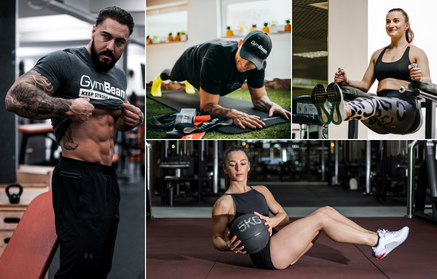
Add a comment